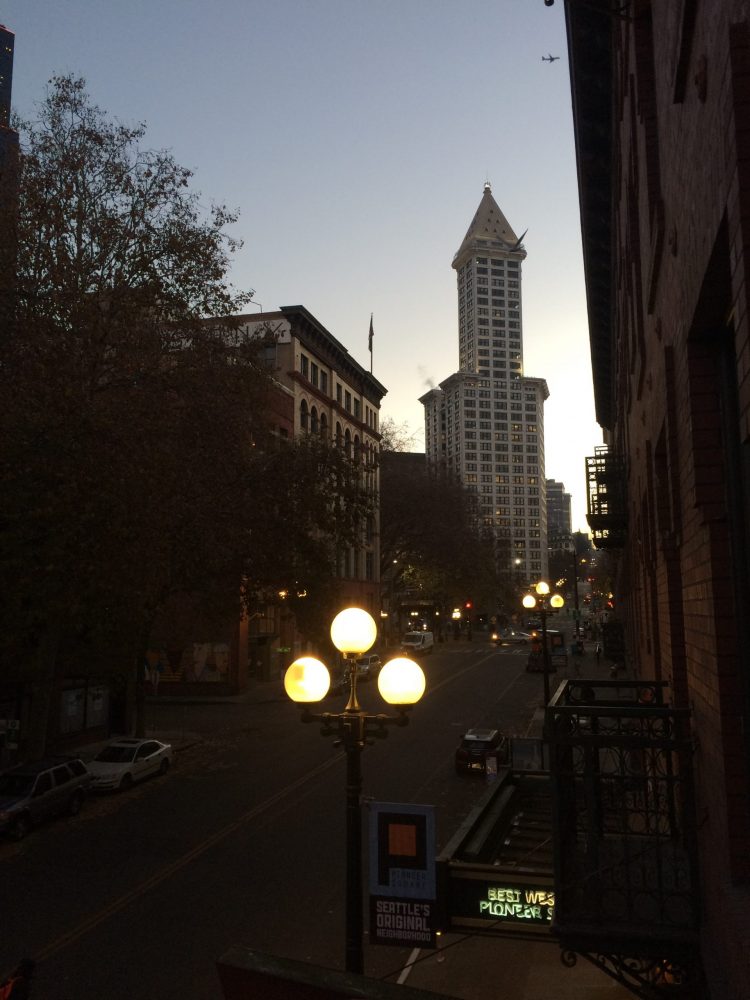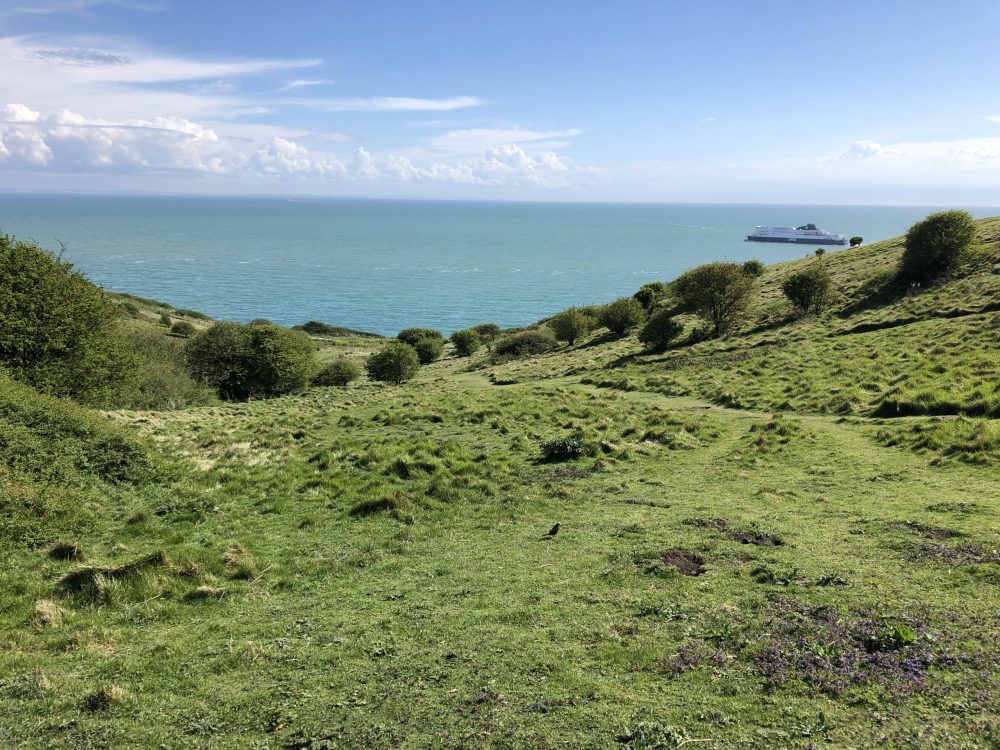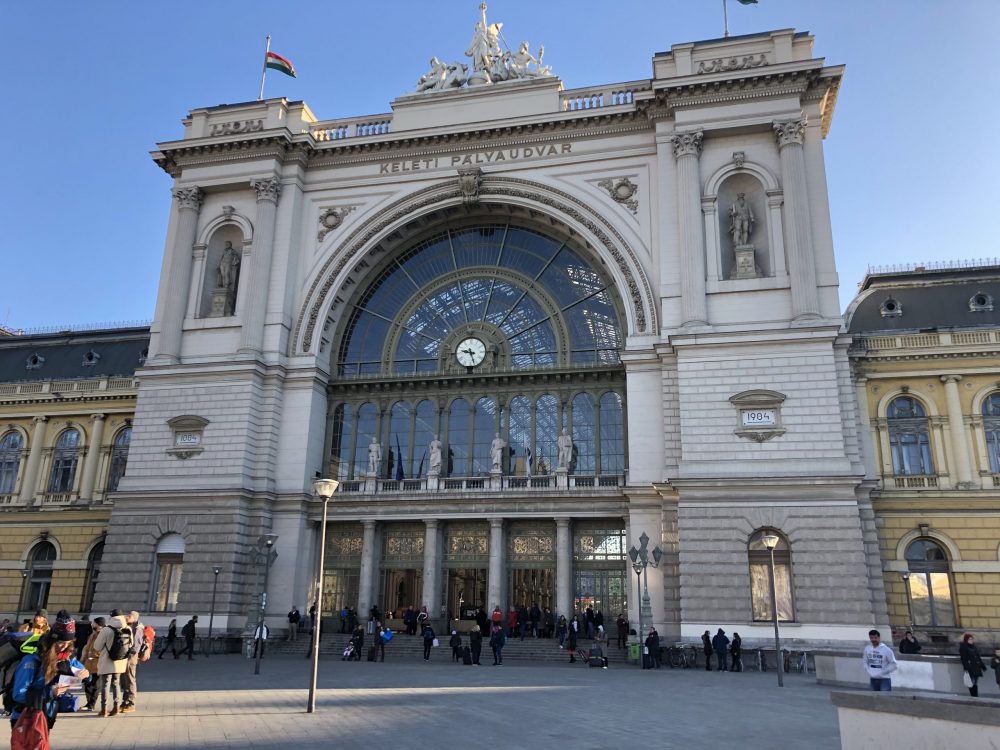


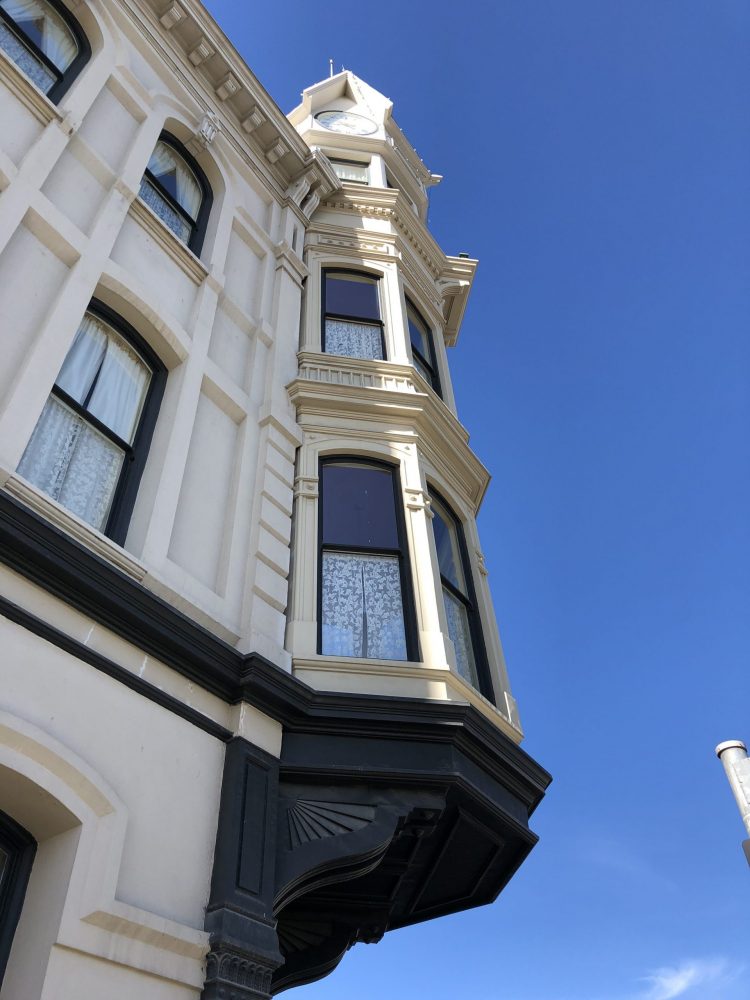
The Geiser Grand Hotel in Baker City is a place I have been dreaming of visit for probably over a decade. A chance scanning of an Oregon travel magazine in a waiting room left me gawking at the interior shots and gorgeous stained glass ceiling of this hotel. I may have stolen the magazine from the waiting room (this was before I owned a cell phone that took decent pictures). So when I planned the road trip this last summer I knew this hotel was on the list, truth be told I planned the entire trip around three hotels I wanted to visit (Frenchglen, Idaho Hotel and Geiser Grand).
History of Geiser Grand Hotel
The Geiser Grand Hotel opened in 1889, designed by John Bennes in the Italianate Victorian Style. Bennes is responsible for a number of buildings in Oregon including 35 on the University of Oregon campus, as well as the Hollywood Theater in Portland and the Liberty Theater in Astoria (both incredibly gorgeous and still working theaters).
The hotel was build during the Oregon Gold Rush and as such saw its fair share of incredibly wealthy and incredibly shady characters throughout its history. In 1968 the hotel closed and in 1993 it was reopened after an enormous restoration effort which brought the hotel back to life with historic fixtures, paint colors and furnishings. Including an enormous research process to design and remake the stained glass ceiling which had long since been destroyed in a hail storm.
Hauntings of the Geiser Grand Hotel
For those of you interested in the paranormal the Geiser Grand Hotel has had numerous spectral sightings. Which include a young girl, a saloon dancer, a cowboy, a headless chef, and a lady in blue. A quick internet search will bring you all kinds of confessions of sightings and even information about a ghost hunters type crew that camped out set on finding definitive evidence of the hauntings.
For those of you not interested in the paranormal I can tell you without a doubt that I experienced nothing but a stellar stay and an excellent nights sleep.
Out Stay at the Geiser Grand Hotel
I was so thrilled to finally be experiencing this incredible historic hotel, I was on cloud nine the entire stay. It probably helped that I hadn’t had a decent shower in a couple days or a very great bed in the last couple days. I was beat.
I wandered around the hotel for a good while snapping pictures and seeing that all the hotel had to offer. A reading/game room, a gym, a dining room and a store were all on premises. And the store even had movies for rent that could be played in the room.
Once I had sufficiently went everywhere I could without risking ejections from the hotel, we got ready for dinner. We chose not to eat at the hotel because I had found a steak house in Haines that looked like a hoot. But we returned with full bellies, dessert to go and settled in for a couple movies. This was the first time we had decent wi-fi all week so we picked a few Netflix movies and streamed them from bed.
The rooms are absolutely stunning, well decorated, large windows and gloriously tall ceilings make the rooms seem palatial. The beds and pillows were superb, I don’t think I have had a better nights sleep since. We had breakfast in the dining room and then set off toward Portland. All in all I give the Geiser Grand Hotel 5 stars, beautiful, historic, comfortable, interesting history, and no actual ghost encounters.
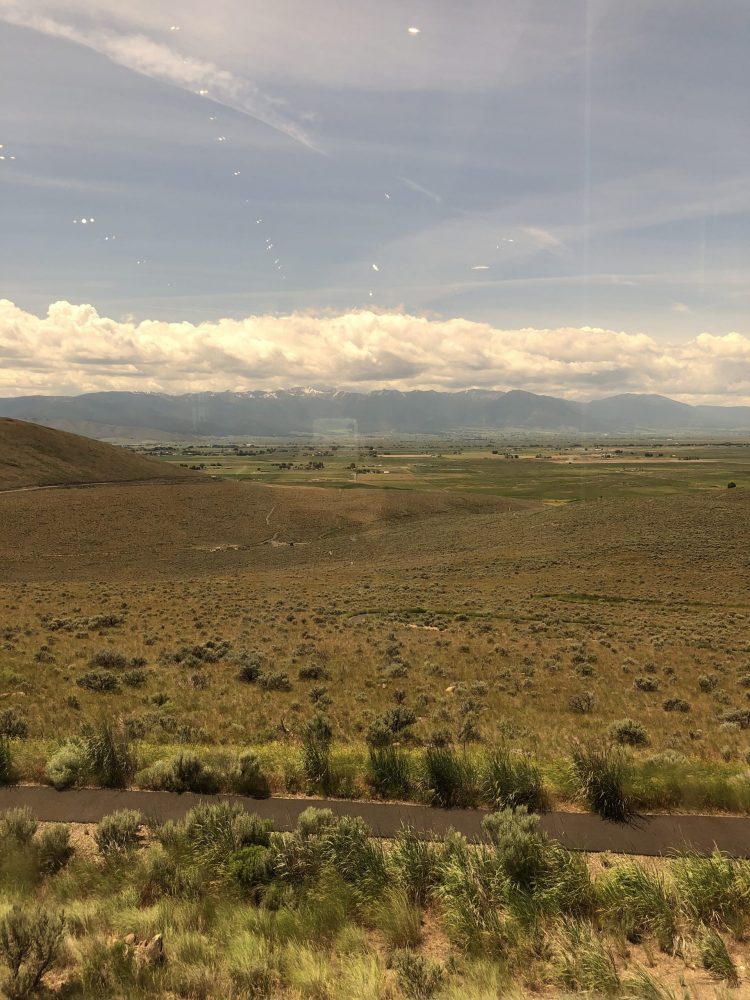
Right off I-84 in eastern Oregon is the Oregon Trail Center. Providing visitors a variety of experiences related, well, the Oregon Trail. I have very little reason to be approximately 6 hours away from my home, but this last summer as a part of my ‘getting to know Oregon better’ quest I found myself way out east. And knew I needed to make a stop at the museum.
Overview of the Oregon Trail Center
The museum itself lies just north of Baker City, which in and of itself is not a very large town, but it does happen to be a very important role in Oregon’s history. A lot of wagon trains passed through this area. After long harrowing journeys families were greeted with wide open pastures and the unfortunate realization that they still had mountain passes to traverse.
The Oregon Trail Center is an incredible museum maintained by the Bureau of Land Management. It offers sweeping view of the area, as well as life sized displays, films, exhibits, presentations and more.
The buildings and views are well worth the drive, sitting on top of a large hill in the middle of BLM land, you get the opportunity to experience an unobstructed view of the valley and Rock Creek Butte. You can also hike all over this area, BLM lands are open for recreation. The types of recreation are always clearly marked or communicated on the areas website if you have any questions regarding land use.
The facilities also have a very nice walking path down the face of the hill and out toward some mines that are set up for educational purposes. I being terrified of ticks, did not choose to go tromping through the open lands and stuck to the path being sure not to brush up against any long grasses. We saw plenty of ticks just walking by. So if you choose to hike through the pastures be sure to come prepared and always check for ticks after being outside.
My Impressions of the Oregon Trail Center
We had been driving for quite a few hours by the time we got here, and having left Silver City behind (sadly) I think we were both a little dazed. And for some reason I had in my mind that it would be providing research materials to look through in order to locate names and dates of family members that passed through the area but it did not. And that is okay, it is a lovely area with a wonderful exhibit.
There isn’t really anything in the area of the museum, hence the beautiful sprawling views. But just down the road is an excellent steak house Haines and Baker City is only about 10 minutes down the highway so it is an easy jaunt into town for excellent hotels, restaurants and other museums.
I thoroughly enjoyed by time at the Oregon Trail Center in Baker City Oregon. One I highly recommend if you are interested in Oregon history and find yourself in the area.

The absolute best thing I did this year was spend the night in a ghost town. Silver City and the Idaho Hotel are truly a treasure of American history and the old west. I cannot wait until next summer so I can make the grueling 500 mile drive back to spend more than just a night in Owyhee Mountains, it is well worth the drive.
History of Silver City and The Idaho Hotel
Silver city was a mining town, mostly silver but some gold as well. It was a very bustling town in the 1800s with a population of 2,500 it boasted 75 businesses and was the county seat until 1934. In the late 1880s one of the largest stage coach lines in the west operated through the area and in the 1890s electricity was brought to the area. It was even once considered one of the four major settlements in the Idaho Territory.
However about the time that Idaho officially become a state the mines were depleted and people slowly moved out of the area. The electricity was removed and rerouted to a nearby airbase and due to its remote location the city was left largely abandoned.
It was never entirely abandoned though, descendants of original settlers and intrepid mountain folk have keep the spirit of the place alive through handwork and a love of the unique site. Several families maintain houses in the area, returning each summer once the mountain roads are open again to spend their summers in the solitude of the quite community. During the open season there are several events to help raise funds to pay for a winter watchman who spends the winters in the cold mountains accessible only by snowmobile until the weather turns each year.
The Idaho Hotel was originally build just down the road in Ruby city, but in 1866 Rudy City lost the county seat and so the Idaho Hotel and many other buildings in town were dismantled, loaded on sleds and moved up the river to Silver City. In 1868 the popular hotel got running water, making the stay for those in town on business with the county much more comfortable. By 1889 a gambling hall, barroom, kitchen, bathrooms, and billiards parlor were all completed with hand milled woodwork from local craftsman. And by 1898 a five story addition was completed which included two stories of rooms, a dining room and a basement with storage tunnel beneath the hotel connecting to the mining shaft.
In 1942 due to the city losing the county seat, its power lines and the mines being shut down the hotel was closed and soon fell to disrepair. But In the 1972 Edward Jagels bought the Idaho Hotel which had been previously abandoned 30 years prior and began the slow process of restoring the old hotel. The current owners bought the hotel from Ed in 2001 and continue to operate the hotel and restore it.
Getting to Silver City and the Idaho Hotel
I won’t lie to you and say getting to Silver City is easy. Even if you don’t live several hundred miles away it is still quite the adventure. Today the city sits on land owned by the Bureau of Land Management, so the roads are somewhat maintained. I say somewhat because yes there are roads, but you need a four wheel drive vehicle with plenty of clearance to get there safety. I was told the fire department is dispatched several times a summer to rescue folks who have gotten themselves stuck. Before you embark on your trip be sure to have written directions, a map and a compass. You will not have cell service or GPS satellite.
If coming from the Oregon side, when you leave Jordan Valley, it is a left at the first fork where you leave the pavement behind in favor of a gravel road. You will encounter three more forks in the main road, but with no road sign to follow. The first fork is a right (there is a sign for Silver City here), the second a left (a sign for a mining company) and the third is a right ( at the public restroom). The Oregon approach is by far the harder of the two, the roads are in much worse condition. From the Idaho side, take the main road up from the main highway continue left at the public restroom and you will be there in no time. We came from the Oregon side having driven over from the Frenchglen Hotel.
Visiting Silver City and the Idaho Hotel
There are several events throughout the season in the area, mostly to help raise funds to pay for building repairs and the winter watchman. The area usually opens in late May around Memorial Day Weekend and stays open until the first snow. The main event is the open house which takes place two weekends after Labor Day every year, where local families open their houses for the public to walk around and learn about the town. There are also holiday celebrations for the 4th of July and Labor Day.
We went for the sheer joy of staying in and exploring a ghost town and spent our time either hiking around or chatting it up with the hotel owners. It may have been summer, but it was the beginning of summer and it was cold. At six thousand feet above sea level, the snow had barely cleared from the mountain passes and it had been snowing the day before we arrived. We didn’t see any ourselves, but it was raining a bit when we got there. After checking in and being shown to our room, one of four with a working heater, we put on as much of the clothing as we had packed as possible and set out to walk around.
Every building in town is privately owned so exploring was done with utmost respect. We wandered around the roads, which are more four-wheel tracks than anything. And found ourselves at the top of the ridge overlooking the hotel where the school and church buildings are. Both of which were closed. Had we visited during the open house week however, we would have been able to go inside.
There are several building for sale at present, one of which is the masonic building that spans the small creek that runs through town. However no bank will ever loan money to buy buildings in town (as confirmed by the hotel owner) so individuals looking to own a heavenly slice of this secluded town must bring cash offers, plus plenty of money to help restore the old buildings.
After walking every road in town, talking to everyone we came across, and making our way up to the cemetery for a little look around. We wandered back to the hotel, where I couldn’t resist a little look around, largely with my cell phone operating as a flash light since the small solar power grid only provides very weak LED lighting and not every room is wired. I respectfully did not wander up to the third floor even though I was dying to see it, and also a little spooked thus a tad relieved to see the sign not to go up the stairs. After our look around we went back to our room cranked the heat, broke out the cheese and crackers and watched a downloaded episode of the Ted Bundy story on Netflix.
Since the power lines were diverted to the airbase many years ago, and given the lack of cell service we knew going in that if we wanted to watch anything we would need to download it ahead of time. We also knew we would need to have fully charged devices and backup batteries. Upon checking in the owners will remind you of the sensitivity of their solar power grid, long story short don’t even think about plugging in a phone or a hair dryer. You would kill the power to the entire hotel. And since the hotel is the only place in town to eat, you would be effectively ruining any chance of getting fed during your stay. You would probably also be asked not to return.
At the appointed time we made our way down to the main dining room which leans ever so slightly outward so while eating dinner you feel a bit like standing on a cliff. The dining room is likely no different than it was in its heyday, a little rough and tumble flanked by a gorgeous hand plained bar on one side and antique shelves covered in artifacts from the town. A veritable museum of the towns history which was thankfully heated by a gigantic cast iron wood stove in the center. It was the warmest part of the hotel and we wound up staying quite a while during both dinner and breakfast chatting with the owners and their daughter. A couple hours after we had finished our dinner a group of locals made their way to the dining room and we made a graceful exit back to our room. The diner was delicious and huge, we were tired and stuffed so we went back to watching our downloaded Netflix and settled in for the night.
We had zero encounters with things that go bump in the night. The daughter of the hotel owners ensured me that never once had she experienced anything weird in the hotel. I felt 100 percent safe and comfortable the entire time. But that doesn’t mean I was thrilled to have to use the restroom in the middle of the night which was outside our room and down a very long, dark, freezing cold hallway. When morning came, despite the constant running of our heater (we got one of the few rooms with heaters) the windows were frosted over, and our truck had to be de-iced. We once again made a mad dash in all our clothes down to the dining room to fill up on hot coffee and stand around the stove.
We chatted with the owners more after breakfast, getting a tour of found objects in the area, like these opium bottles with intact labels. We learned all about the history of the town and the hotel. We got to hear funny stories about locals and what it was like growing up there. We listened with rapt attention to stories about renovations, brining ovens and fridges up to the hotel in the dead of winter on sleds. And thankfully unfounded evacuation plans during fire season. We were both reluctant to leave, feeling kindred spirits with this lovely family whose seasonal life and cautionary tales reminded us both so much of the fishing season. The migration every year, the off the grid lifestyle, the characters you meet and the friends that become your family. It felt like home and it was difficult to pull our selves away. But our long drive ahead and the trepidation of meeting tourists coming up the hill on the narrow roads finally motivated us to head down the mountain.
The drive down was blissfully easier on the Idaho side, though marked by the occasional traveler the road was much wider and entirely covered in crickets. Big super jumpy fat Morman Crickets which were clearly in their swarm phase. A couple times we wanted to get out and take pictures of the views but the fact that they were jumping close to two feet in the air kept us locked in the cab the entire way down the mountain.
We ended our ghost town adventure with smooth sailing north through Idaho to cross over to Baker City Oregon for the night. While our stay there was much more luxurious I will always prefer the adventure and sense of belonging from places like Silver City and the Idaho Hotel. I hope to make my way back next year, hopefully later in the sumer for a couple nights so I can make use of the ample hiking in the area.


If you have ever had to itemize a hotel bill for an expense report you will know that the United States has lodging taxes attached to hotels. Fun fact, it is not legally required in every state. I must have been “lucky” to have traveled to all the states that require it as I swear I spent more time trying to work my expense report than I did at the conference I was sent to.
But we Americans are not the only ones with this tax. The hotel tax, or value added tax (VAT for short), is fairly common in Europe. London for example has a 20% tax on lodging, Germany I believe is 7% in some spots and 19% in others.
Since I often don’t stay in hotels and instead opt for short term apartment rentals the VAT’s aren’t quite as high. I think when we last stayed in Austria we only paid an extra dollar a night. But we did have to fill out a temporary residency card which was turned in to the police by the management team along with our taxes. This isn’t anything weird I promise! I had to do it while I was there for school as well.
However when I am doing a more hop and go type trip I have since decided to not worry about the taxes. It is just a given travel expense for the most part. If you would like to learn more about them and perhaps like to try to save some money by applying for refunds below are a few resources I have found around on the internet.
https://www.ricksteves.com/travel-tips/money/vat-refunds
http://gogreece.about.com/od/Glossary-of-Greek-Terms/g/Vat-Or-V-A-T-Tax-In-Greece.htm
http://europa.eu/youreurope/business/vat-customs/buy-sell/index_en.htm
The point here really is to know your expenses. Lodging taxes can add up quickly and become a significant portion of your travel budget if you aren’t careful. Additionally many locations can appear cheap only to charge you taxes you weren’t aware of when you arrive at your stay. Even if you aren’t worried about a few extra dollars here and there it is good to understand why you are being charged and where that money is going.
Question:
Have you ever tried to get refunds for VATs? Or do you also just let them slide and write them off as a normal travel expense?
